The AI-1 Dreadnought Project Pt.1
Comments
-
Just checked - my first post in this thread was almost 3 years ago.
This is one of those threads that keeps on giving.About time I got this project done!
I just finished my second unit and a transformer upgrade to my first.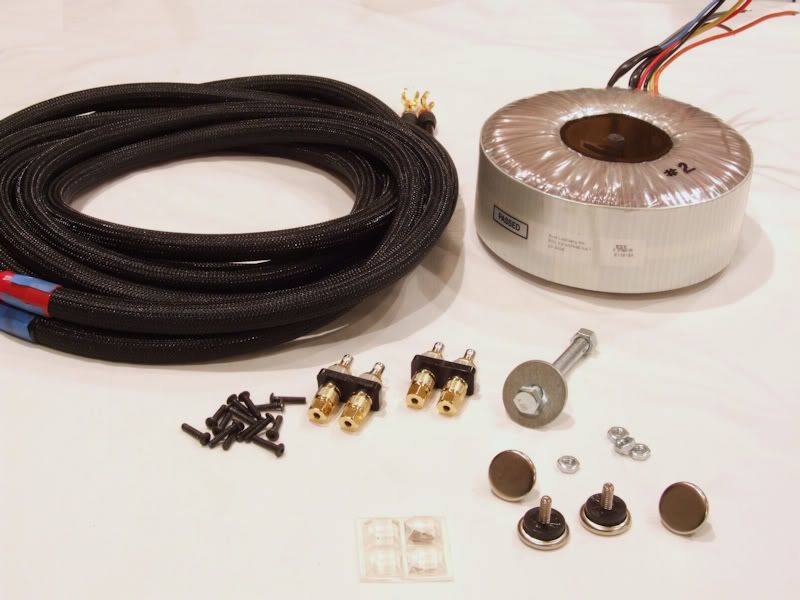
Dreadnought parts for a pair of CRS+'s.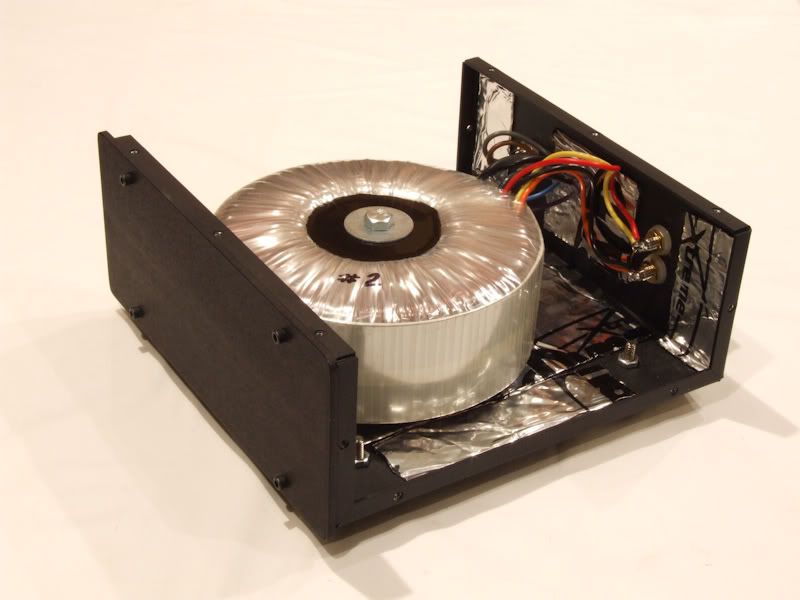
I had about 1/4" of clearance in the front of this smaller 10" x 10" x 4" case. I would have just drilled a new
mounting hole further back if I hadn't had enough space in front.
The obligatory Dynamat Xtreme to damp case ringing.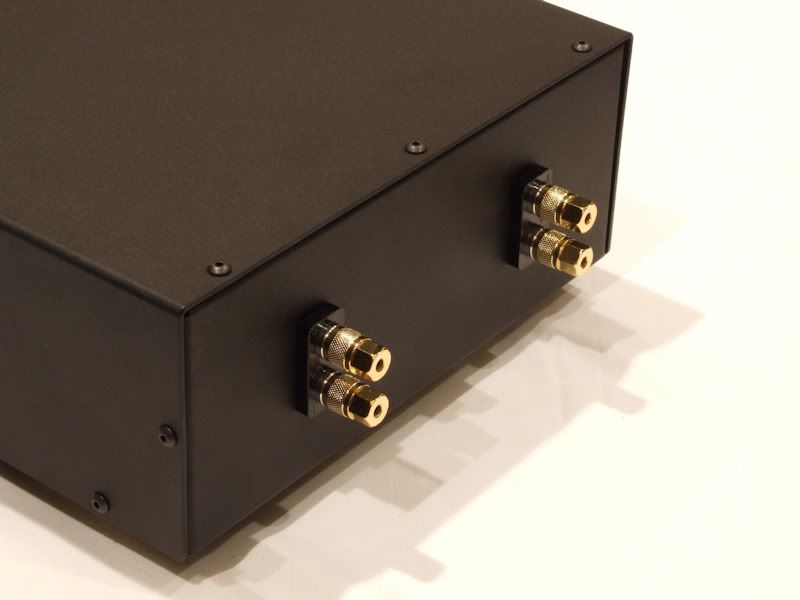
The obligatory Cardas CCGR-S binding posts...only because they look so good.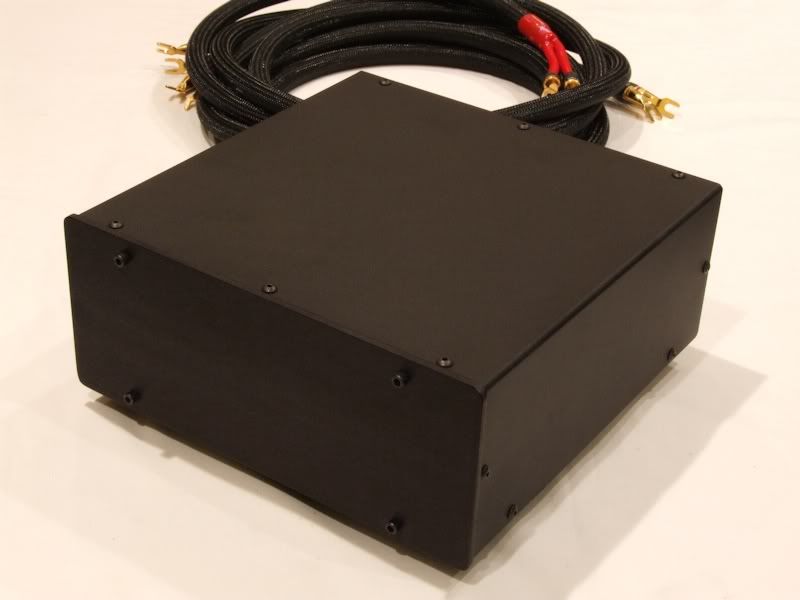
Figure 19. Completed Dreadnought assembly with Monster Cable Z3 Reference speaker cables.Is there any reason not to build a case from wood?
Wood is fine. Metal can offer shielding from environmental noise sources.Proud and loyal citizen of the Digital Domain and Solid State Country! -
Ray,
What transformer upgrade did you do? -
How can I be so rude as to not thank Ray for all the knowledge sharing and motivation to do this project? Can't thank you enough for all the help over the years!Good music, a good source, and good power can make SDA's sing. Tubes make them dance.
-

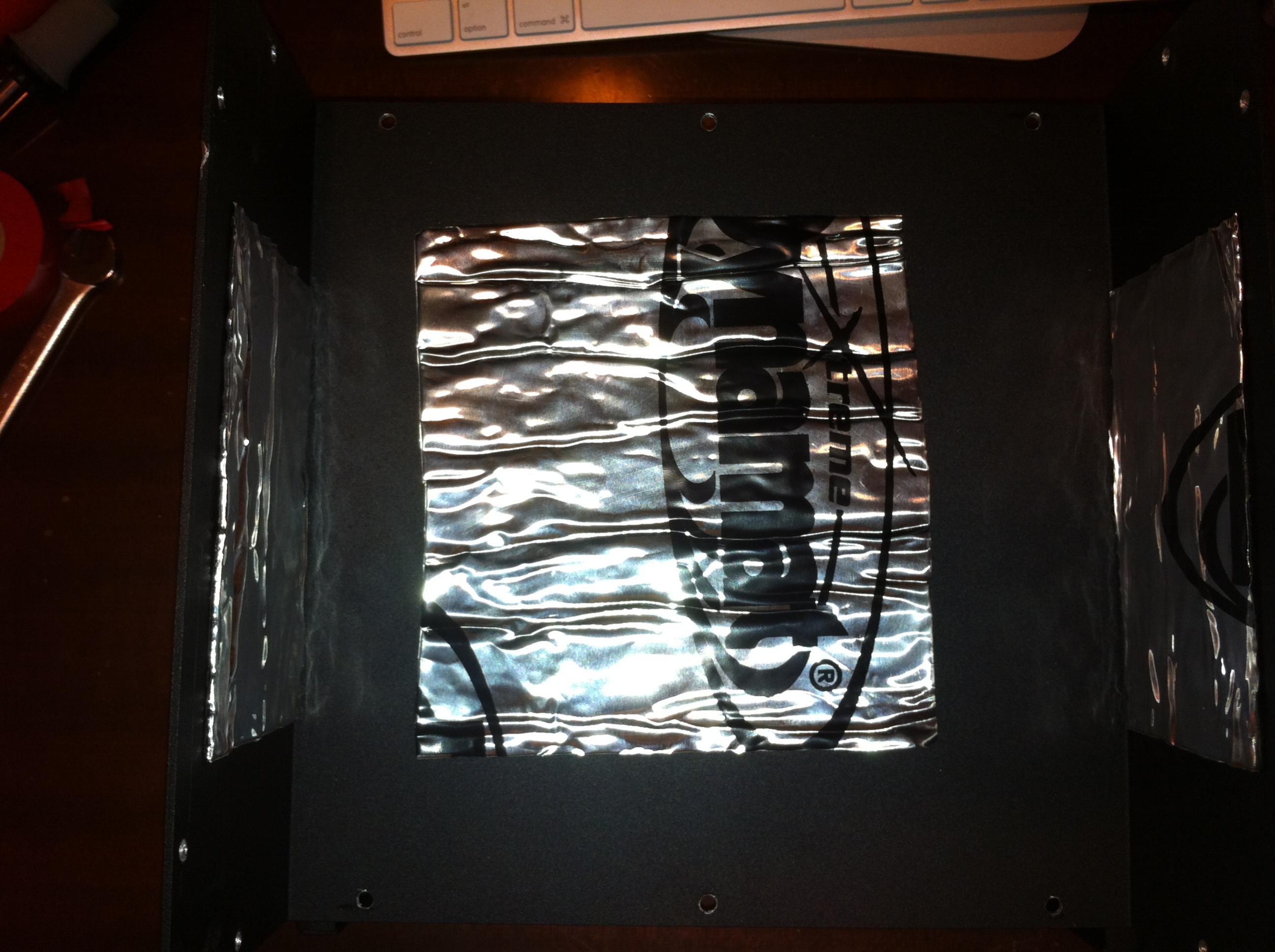
Interior pics of the new Dreadnaught. Very psyched I finally got this done!Good music, a good source, and good power can make SDA's sing. Tubes make them dance. -
Ray,
What transformer upgrade did you do?
Avel Lindberg AV-047548, 1000VA. Details soon.How can I be so rude as to not thank Ray for all the knowledge sharing and motivation to do this project? Can't thank you enough for all the help over the years!
Thank Matt Polk too for starting things off with the toroidal transformer recommendation.Proud and loyal citizen of the Digital Domain and Solid State Country! -
Got my Dreadnaught cables back from Frank yesterday. I had a 12' run of Signal Ultra speaker cable that I was using as an SDA interconnect. I had him make that cable for me with each side terminated with one spade and one banana. I had been mounting both the spade and the banana on the Cardas posts that I used for the SDA connector when I modded my 1C's, so I was using both sides of the cable in parallel as my SDA connection.
I sent that cable back to Frank and had him cut it in half, and terminate the new ends with bananas. So now the new ends with the bananas attach to the Dreadnaught, and the old ends with the spade/banana attach to the speakers. Banana side goes to the SDA post, spade side goes to the ground. The speaker wires from the amp are bananas, so the spade from the Dreadnaught cable and the banana from the speaker cable both attach to the ground post, works like a charm.Good music, a good source, and good power can make SDA's sing. Tubes make them dance. -
Got my Dreadnaught cables back from Frank yesterday. I had a 12' run of Signal Ultra speaker cable that I was using as an SDA interconnect. I had him make that cable for me with each side terminated with one spade and one banana. I had been mounting both the spade and the banana on the Cardas posts that I used for the SDA connector when I modded my 1C's, so I was using both sides of the cable in parallel as my SDA connection.
I sent that cable back to Frank and had him cut it in half, and terminate the new ends with bananas. So now the new ends with the bananas attach to the Dreadnaught, and the old ends with the spade/banana attach to the speakers. Banana side goes to the SDA post, spade side goes to the ground. The speaker wires from the amp are bananas, so the spade from the Dreadnaught cable and the banana from the speaker cable both attach to the ground post, works like a charm.
What amp are you running and is it common ground? How does it sound? What changes, if any, are you hearing?"Science is suppose to explain observations not dismiss them as impossible" - Norm on AA; 2.3TL's w/sonicaps/mills/jantzen inductors, Gimpod's boards, Lg Solen SDA inductors, RD-0198's, MW's dynamatted, Armaflex speaker gaskets, H-nuts, brass spikes, Cardas CCGR BP's, upgraded IC Cable, Black Hole Damping Sheet strips, interior of cabinets sealed with Loctite Power Grab, AI-1 interface with 1000VA A-L transformer -
Krell KAV-2250.
Yes, it is common ground. I've been noticing much more impact with bass. That's the main difference, which I'm quite happy with. I was already in a pretty good place with using an upgraded cable over the stock pin-blade, since my amp is common ground. So I wouldn't call it a dramatic difference, only thing I've noted so far is the bass. But I like bass So it's a keeper! Good music, a good source, and good power can make SDA's sing. Tubes make them dance.
So it's a keeper! Good music, a good source, and good power can make SDA's sing. Tubes make them dance. -
DarqueKnight wrote: »I did hear a moderate improvement when the Dreadnought was placed in its $200 aluminium enclosure. This was a pleasant surprise...
...I had some concerns about electromagnetic interference since the Dreadnought would be sitting right next to a big fat (but well shielded) power cable and a big fat power amp with its accompanying big fat electromagnetic field. The Dreadnought, while still attached to the wood platform, was measured and listened to while it was placed behind the speaker (right next to a power cord), again when placed next to one of the JC 1 amps, and again when placed on top of the audio cabinet. I neither heard nor measured a difference at any location.
Immediately after the Dreadnought was placed in its aluminium enclosure, I was hearing more. More detail. More bass. More liquidity. More velvety smooth inky black background behind the music. The dead (quiet) spaces between songs on a CD began to call attention to themselves like a pregnant pause.
I dug out the oscilloscope once again to have a look at what I was hearing. I already knew that aluminium, and other non-ferrous metal enclosures, provide a measure of shielding against electromagnetic interference. This was the first time I had heard and measured the effects of such shielding.DarqueKnight wrote: »...Comparing figures 17 and 31, the Volcano's FFT plots at 1000 Hz show a drastic reduction in noise between the wood bound prototype and the aluminium clad Dreadnought...
...I noted that the sound of the Dreadnought improved when its transformer was placed in an aluminium enclosure. I wrapped the AI-1 in 5 6" x 9-1/2" sheets of aluminium foil and heard an improvement in detail and depth. I added an additional five sheets of foil and heard additional improvements in detail and depth. Readers using AI-1's may realize some benefits by wrapping their transformer enclosures in aluminium foil or by placing it in an unvented aluminium enclosure. I did not measure or hear further improvements beyond adding 10 sheets of foil. The amount of foil required to reduce noise to an acceptable level will probably vary depending on your environment and associated equipment.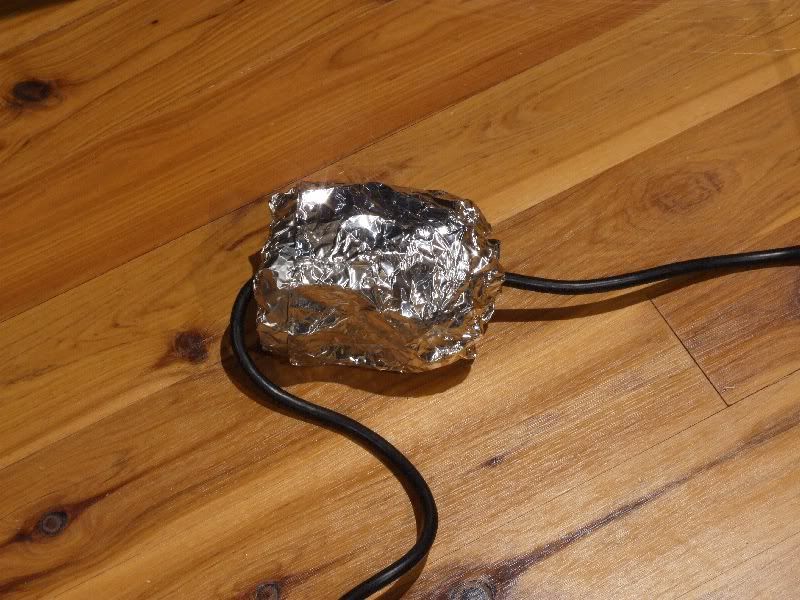
Figure 33. Dont laugh. Wrapping the AI-1 in sheets of aluminium foil resulted in audible and measurable improvements.DarqueKnight wrote: »Aluminum is 40% less conductive than copper and is 9% less conductive than gold. Aluminum has the advantage that its conductivity to weight ratio (specific conductivity) is twice that of copper.
An aluminum wire with the same conductivity, or current capacity, as a copper wire will be 40% larger, but will have half the weight and lower cost. Aluminum typically costs 7% to 100% less than copper depending on market conditions and the application requirements. That is why aluminum is widely used for electric transmission lines, transformers and electronic gear cases that must have shielding properties.
Very curious:
1. Regarding the shielding and it's effect on the sound quality: Does the shielding prevent RFI from getting OUT of the AI-1/Dreadnought transformer and into the music signal path of the associated equipment; or does it prevent RFI from getting INTO the transformer and thus **** up the SDA transfer signal?
2. You've said that NON-FERROUS metal makes a good shield. Is that because it's non-magnetic, or because it's a better electrical conductor than steel, or because it has some other property I'm not aware of?
3. Would the shield work better if it was grounded to the ground pin of an electrical outlet? The shield of an interconnect cable is typically grounded to the amplifier chassis; which is in turn grounded via the electrical cord. A "directional" interconnect cable may only be grounded on one end...but it's still grounded. (Am I correct???)
I have an existing enclosure that is primarily stainless steel which I would like to use with an 800VA transformer. The stainless housing is faintly magnetic, and stainless is a relatively poor electrical conductor compared to copper or aluminum. It would be VERY convenient for me to use this enclosure. I can wrap the inside with copper (or aluminum) sheet easily enough, if that would provide better shielding. Some others have discussed shielding a Dreadnought enclosure with copper sheet, but there's been little follow-up. Advice? Tips? Wrap the transformer like a baked potato and don't bother putting the shielding on the enclosure? -
Wrap the transformer like a baked potato and don't bother putting the shielding on the enclosure?
Set it to 450 degrees for 45 minutes for optimum sheilding.
All good questions. I am interested in the followup. Especially the copper sheilding.Statistics show that 98% of us will die at some point in our lifetime.
The other 2% will work for WalMart. -
1. Regarding the shielding and it's effect on the sound quality: Does the shielding prevent RFI from getting OUT of the AI-1/Dreadnought transformer and into the music signal path of the associated equipment; or does it prevent RFI from getting INTO the transformer and thus **** up the SDA transfer signal?
Both. The case reduces the effect of environmental noise. Silver, gold and copper are better conductors than aluminum, but their high cost and relatively low structural strength make them impractical choices for case material. The case also provides containment for the transformer's magnetic field.
Some transformers have a silicon steel shield around them to reduce the ability to induce noise in nearby electronics.2. You've said that NON-FERROUS metal makes a good shield. Is that because it's non-magnetic, or because it's a better electrical conductor than steel, or because it has some other property I'm not aware of?
High conductivity. Aluminum is fourth in conductivity behind silver, gold, and copper. Aluminum is the most widely used case material for high end electronics. The electric field portion of an ambient (environmental) electromagnetic wave is the part that typically causes the most problems in audio electronics through induced currents. Therefore, high electrical conductivity is typically of more importance than high magnetic permeability in audio electronics. If a sensitive electrical component must be placed within a strong magnetic field, then a shield with high magnetic permeability would be required. I discussed the resolution of induced hum in my high gain phono preamplifier (caused by the power amp transformer 13 inches below) here.3. Would the shield work better if it was grounded to the ground pin of an electrical outlet? The shield of an interconnect cable is typically grounded to the amplifier chassis; which is in turn grounded via the electrical cord. A "directional" interconnect cable may only be grounded on one end...but it's still grounded. (Am I correct???)
The purpose of grounding a cable shield is to avoid ground loops.
This is from "Electromagnetic Compatibility Engineering", a reference text by Henry Ott (2009):
"A solid shield that completely surrounds a product (a Faraday cage) can be at any potential and still provide effective shielding. That is, it will prevent outside electromagnetic fields from affecting circuits inside the shield, and vice versa. Thus, the shield does not need to be grounded, nor must it have its potential defined in such a way to behave as a shield. In most cases, however, the shield should be connected to the circuit common, to prevent any potential difference between the shield and the circuits inside the shielded enclosure." (p. 296, sect. 6.18)I have an existing enclosure that is primarily stainless steel which I would like to use with an 800VA transformer. The stainless housing is faintly magnetic, and stainless is a relatively poor electrical conductor compared to copper or aluminum. It would be VERY convenient for me to use this enclosure. I can wrap the inside with copper (or aluminum) sheet easily enough, if that would provide better shielding. Some others have discussed shielding a Dreadnought enclosure with copper sheet, but there's been little follow-up. Advice? Tips? Wrap the transformer like a baked potato and don't bother putting the shielding on the enclosure?
Stainless has poor conductivity but high permeability (ability to trap magnetic fields). MillerLiteScott used copper shielding with his Dreadnought, you might want to get his insights. I don't recall whether he compared different case materials.
Toolfan66 has used steel and aluminum cases for his Dreadnoughts. If I remember correctly, he didn't hear a difference, but check with him to make sure.
My suggestion is to first see if you hear a difference by placing the transformer in the stainless steel case. From there you can experiment with lining the interior with several sheets of aluminum foil...and on to copper if you hear a benefit from aluminum.
Have fun and let us know how it worked out.Very curious...
Then you should enjoy the information at these links:
Magnetic Shielding Of Transformers At Audio Frequencies
Magnetic Shielding SolutionsProud and loyal citizen of the Digital Domain and Solid State Country! -
Much appreciated! Thank you!
It seems like a bit of copper and the enclosure I have may work out very well. -
This is my first post on this site. However, I have been reading it -- especially this thread -- for several months. I purchased a pair of SDA SRS 1.2 speakers in December to replace my SDA 1Cs that I had been using since purchasing them new in 1989 or 1990. In June, I purchased a pair of Perreaux Prisma 750 monoblocks to drive them and a Prisma SM6 MKII preamp to control the monoblocks. I use a Cambridge Audio Azure 840C as my source, using it as a DAC for my Wadia 171 iPod transport when appropriate. My interconnects are AudioQuest King Cobra XLRs, and my speaker cables are Morrow SP7s. Power cords are all OEM stock cables.
When I connected the monoblocks, I got no sound from the right channel and a truly frightening sound when the system was shut down. I learned from Perreaux that the 750s are "bridge ground," and that the SDA SRSs require a common ground amp from reading the SDA SRS manual. Fortunately, the Perreaux folks referred me to DarqueKnight's work on the amplifier interface required to remedy the problem I experienced.
I have now completed the fabrication of the prototype for my "Dreadknought" amplifier interface using a Toroid Corporation of Maryland 600V transformer because that is the transformer the Perreaux folks recommended. I would have chosen the 1000V transformer used by DarqueKnight, but felt it would be best to follow the Perreaux recommendation.
My prototype is enclosed in an 11/32" plywood enclosure that I built as a model for a 3/8" aluminum enclosure for which I have procured components, including the Cardas CCGR binding posts and Dynamax insulation that I will use on the aluminum enclosure.
I'm writing this for two reasons: First, to thank all those who contributed to this thread and made it possible for me to solve my problem with relative ease. Without those contributions I would likely never been able to solve my problem because I do not have the knowledge to tackle it on my own.
Second, I just wanted to add to this thread that when I tested my prototype in the plywood enclosure, both my wife and I noticed a dramatic improvement in the sound reproduction versus the unenclosed transformer. The soundstage was wider and deeper, the bass was more defined and pronounced, and the midrange was richer and clearer.
When I complete work on the aluminum enclosure, it will be interesting to see whether there is a comparable improvement.
I am also curious about others' experiences with upgrading the tweeters and drivers in the SDA SRSs. Are there upgrade options that made significant improvements in the clarity and definition of midrange and high frequencies and reduce "congestion" in the midrange of orchestral recordings?
Again, thanks to all for the contributions they have made to this thread -- especially to DarqueKnight -- and I look forward to any comments that others may have about my questions.Family Room, Innuos Statement streamer (Roon Core) with Morrow Audio USB cable to McIntosh MC 2700 pre with DC2 Digital Audio Module; AQ Sky XLRs to CAT 600.2 dualmono amp, Morrow Elite Speaker Cables to NOLA Baby Grand Reference Gold 3 speakers. Power source for all components: Silver Circle Audio Pure Power One with dedicated 20 amp circuit to main panel.
Exercise Room, Innuos Streamer via Cat 6 cable connection to PS Audio PerfectWave MkII DAC w/Bridge II, AQ King Cobra RCAs to Perreaux PMF3150 amp (fully restored and upgraded by Jeffrey Jackson, Precision Audio Labs), Supra Rondo 4x2.5 Speaker Cables to SDA 1Cs (Vr3 Mods Xovers and other mods.), Dreadnaught with Supra Rondo 4x2.5 interconnect cables by Vr3 Mods. Power for each component from dedicated 20 amp circuit to main panel, except Innuos Statement powered from Silver Circle Audio Pure Power One. -
Someone at Perreaux is a Polkie. Cool.Moose68Bash wrote: »the Perreaux folks referred me to DarqueKnight's work on the amplifier interface required to remedy the problem I experienced. -
I am also curious about others' experiences with upgrading the tweeters and drivers in the SDA SRSs. Are there upgrade options that made significant improvements in the clarity and definition of midrange and high frequencies and reduce "congestion" in the midrange of orchestral recordings?
Again, thanks to all for the contributions they have made to this thread -- especially to DarqueKnight -- and I look forward to any comments that others may have about my questions.[/QUOTE]
The answer to improving clarity is yes. New tweeters will help the highs and upper mids tremendously; installing Black Hole 5 strips did wonders for removing mid range congestion in my 2.3TL's, dynamatting the MW driver baskets helps too.
I'd also say if you really want to take these up to the next level replace all the caps on your Xover with high quality film caps, and the resistors with non-inductive wire wound resistors.
If none of these mods have been done you haven't really heard what your speaks can do.
Search the forum and you'll find lots of thread about these.
And welcome to CP!"Science is suppose to explain observations not dismiss them as impossible" - Norm on AA; 2.3TL's w/sonicaps/mills/jantzen inductors, Gimpod's boards, Lg Solen SDA inductors, RD-0198's, MW's dynamatted, Armaflex speaker gaskets, H-nuts, brass spikes, Cardas CCGR BP's, upgraded IC Cable, Black Hole Damping Sheet strips, interior of cabinets sealed with Loctite Power Grab, AI-1 interface with 1000VA A-L transformer -
Thank you, drumminman. After I finish my aluminum enclosure for the Dreadnought, I shall embark upon an upgrade path. Because my technical skills are not equal to all the tasks involved, I'll have to get some outside assistance on, for example, modifying the crossovers.Family Room, Innuos Statement streamer (Roon Core) with Morrow Audio USB cable to McIntosh MC 2700 pre with DC2 Digital Audio Module; AQ Sky XLRs to CAT 600.2 dualmono amp, Morrow Elite Speaker Cables to NOLA Baby Grand Reference Gold 3 speakers. Power source for all components: Silver Circle Audio Pure Power One with dedicated 20 amp circuit to main panel.
Exercise Room, Innuos Streamer via Cat 6 cable connection to PS Audio PerfectWave MkII DAC w/Bridge II, AQ King Cobra RCAs to Perreaux PMF3150 amp (fully restored and upgraded by Jeffrey Jackson, Precision Audio Labs), Supra Rondo 4x2.5 Speaker Cables to SDA 1Cs (Vr3 Mods Xovers and other mods.), Dreadnaught with Supra Rondo 4x2.5 interconnect cables by Vr3 Mods. Power for each component from dedicated 20 amp circuit to main panel, except Innuos Statement powered from Silver Circle Audio Pure Power One. -
Drumminman, where can I find information about how and where to install Black Hole 5 strips? I have a vague memory of having read a post about this, but I haven't been able to find it again. Thanks.Family Room, Innuos Statement streamer (Roon Core) with Morrow Audio USB cable to McIntosh MC 2700 pre with DC2 Digital Audio Module; AQ Sky XLRs to CAT 600.2 dualmono amp, Morrow Elite Speaker Cables to NOLA Baby Grand Reference Gold 3 speakers. Power source for all components: Silver Circle Audio Pure Power One with dedicated 20 amp circuit to main panel.
Exercise Room, Innuos Streamer via Cat 6 cable connection to PS Audio PerfectWave MkII DAC w/Bridge II, AQ King Cobra RCAs to Perreaux PMF3150 amp (fully restored and upgraded by Jeffrey Jackson, Precision Audio Labs), Supra Rondo 4x2.5 Speaker Cables to SDA 1Cs (Vr3 Mods Xovers and other mods.), Dreadnaught with Supra Rondo 4x2.5 interconnect cables by Vr3 Mods. Power for each component from dedicated 20 amp circuit to main panel, except Innuos Statement powered from Silver Circle Audio Pure Power One. -
Go here to read a description of the install, and a review: http://www.polkaudio.com/forums/showthread.php?128159-Black-Hole&highlight=black+hole
Remember, that you'll still use the original polyfill.
I bought mine here: http://www.soniccraft.com/products/damping/blackhole5.htm They are having a sale right now, though I don't know if Black Hole is included. I'd call and ask. The stuff is expensive, but I think I only used 1 sheet on my 2.3TL's."Science is suppose to explain observations not dismiss them as impossible" - Norm on AA; 2.3TL's w/sonicaps/mills/jantzen inductors, Gimpod's boards, Lg Solen SDA inductors, RD-0198's, MW's dynamatted, Armaflex speaker gaskets, H-nuts, brass spikes, Cardas CCGR BP's, upgraded IC Cable, Black Hole Damping Sheet strips, interior of cabinets sealed with Loctite Power Grab, AI-1 interface with 1000VA A-L transformer -
Drumminman, thank you.
I read your thread about the BH5 installation and appreciate the detailed description, including your description of the "ladder" appearance of the final product. I have SDA SRS1.2s, so I may put four horizontal strips behind the tweeters between the vertical strips.
Thank you for the warning about remembering to save and reuse the polyfill. I have a newbie question about the polyfill. I have my MWs and tweeters out now, while I wait for Trey's upgrade of my crossovers and delivery of RD0194 tweeters. When I look at the polyfill and feel around the inside of the cabinet behind it, it is not clear how it is attached, how to remove it without messing it up, and then how to reinstall it. I read in one of Darqueknight's posts that he repaired drooping polyfill in one of his speakers with "one staple."
Is removing and reinstalling polyfill something that one doesn't have to be too careful about, or is it a delicate process that requires great care?
Thanks for any guidance you can give me.Family Room, Innuos Statement streamer (Roon Core) with Morrow Audio USB cable to McIntosh MC 2700 pre with DC2 Digital Audio Module; AQ Sky XLRs to CAT 600.2 dualmono amp, Morrow Elite Speaker Cables to NOLA Baby Grand Reference Gold 3 speakers. Power source for all components: Silver Circle Audio Pure Power One with dedicated 20 amp circuit to main panel.
Exercise Room, Innuos Streamer via Cat 6 cable connection to PS Audio PerfectWave MkII DAC w/Bridge II, AQ King Cobra RCAs to Perreaux PMF3150 amp (fully restored and upgraded by Jeffrey Jackson, Precision Audio Labs), Supra Rondo 4x2.5 Speaker Cables to SDA 1Cs (Vr3 Mods Xovers and other mods.), Dreadnaught with Supra Rondo 4x2.5 interconnect cables by Vr3 Mods. Power for each component from dedicated 20 amp circuit to main panel, except Innuos Statement powered from Silver Circle Audio Pure Power One. -
Moose68Bash wrote: »Drumminman, thank you.
I read your thread about the BH5 installation and appreciate the detailed description, including your description of the "ladder" appearance of the final product. I have SDA SRS1.2s, so I may put four horizontal strips behind the tweeters between the vertical strips.
Thank you for the warning about remembering to save and reuse the polyfill. I have a newbie question about the polyfill. I have my MWs and tweeters out now, while I wait for Trey's upgrade of my crossovers and delivery of RD0194 tweeters. When I look at the polyfill and feel around the inside of the cabinet behind it, it is not clear how it is attached, how to remove it without messing it up, and then how to reinstall it. I read in one of Darqueknight's posts that he repaired drooping polyfill in one of his speakers with "one staple."
Is removing and reinstalling polyfill something that one doesn't have to be too careful about, or is it a delicate process that requires great care?
Thanks for any guidance you can give me.
No need to put any behind the tweeters just cut 4" wide long strips and put it behind the mids on the back wall of the speakers then cut 2" long strips and put them on the side walls of the speakers behind the mids that will give you all you need in these speakers.
More is not better and less is more IMO.. -
Moose68Bash wrote: »Drumminman, thank you.
I read your thread about the BH5 installation and appreciate the detailed description, including your description of the "ladder" appearance of the final product. I have SDA SRS1.2s, so I may put four horizontal strips behind the tweeters between the vertical strips.
Thank you for the warning about remembering to save and reuse the polyfill. I have a newbie question about the polyfill. I have my MWs and tweeters out now, while I wait for Trey's upgrade of my crossovers and delivery of RD0194 tweeters. When I look at the polyfill and feel around the inside of the cabinet behind it, it is not clear how it is attached, how to remove it without messing it up, and then how to reinstall it. I read in one of Darqueknight's posts that he repaired drooping polyfill in one of his speakers with "one staple."
Is removing and reinstalling polyfill something that one doesn't have to be too careful about, or is it a delicate process that requires great care?
Thanks for any guidance you can give me.
The polyfill I removed from my Polks is a roll of the stuff. When you remove it do it through the hole for the PR - it's easier and you're less likely to tear it. It's not really that delicate, but it's easier to manipulate and more likely to stay in place if it's in one piece.
When I reinstalled mine I rolled it back up and worked it into position. I don't think I used anything to hold it in place, but you could put a staple in it as DK did. The placement is important - be sure it goes from the top of the cabinet to the bottom of the last row of MW's, no lower. If you put it at the level of the PR it will reduce bass output dramatically.
You're doing some great mods. What kind of caps and resistors is Trey using to rebuild your Xovers with?"Science is suppose to explain observations not dismiss them as impossible" - Norm on AA; 2.3TL's w/sonicaps/mills/jantzen inductors, Gimpod's boards, Lg Solen SDA inductors, RD-0198's, MW's dynamatted, Armaflex speaker gaskets, H-nuts, brass spikes, Cardas CCGR BP's, upgraded IC Cable, Black Hole Damping Sheet strips, interior of cabinets sealed with Loctite Power Grab, AI-1 interface with 1000VA A-L transformer -
Drumminman, again, thank you for your advice and interest. I'm undertaking all these mods at once only because of all the work you and others have done and posted in great detail on Polk Club threads and only because guys like Trey and Larry do the work for others that they have learned to do for themselves. I couldn't do much of this without technical help like that from Trey and Larry or advice like that from you and Darqueknight.
Trey recommended and procured Clarity Cap ESAs and Mundorf Mox resistors for the tweeter network and Clarity Cap SAs for the midbass/sda network. He is replacing the SDA and on-board inductors with perfect lay inductors (I don't know the manufacturer). He is using new GIMPOD boards. He is also replacing all binding posts, building new SDA cables for the dreadnought connection, and replacing other wiring, connectors, standoffs, and other miscellaneous parts.
I understand the importance of keeping the damping polyfill out of the PR "void." Thanks for the advice about the care and method needed to remove and replace the polyfill. I'll err on the side of treating it gingerly! I have not yet removed the PRs. I'm not planning to do that and to apply Dynamat Extreme to them till I am ready to begin reinstalling everything else.
One other thing I've noticed: In reading about installations of Larry's rings, nobody (that I recall) has mentioned removing threaded inserts in the MDF for each of the screws to mount the tweeters and drivers. All I have read is about taking care to maintain proper alignment when drilling the holes to enlarge them to accommodate the size of the threaded connectors on Larry's rings.
My SDA SRSs have these metal inserts in each hole for the screws that attach the tweeters and drivers. The inserts are press-fit from the front of the MDF; they do not extend all the way through the MDF and they are not "hurricane nuts." I don't know whether they are glued as well as pressed into the MDF.
Is this just so "conventional" that nobody has bothered to mention removing these inserts? If so, are they glued and how difficult is it to remove them without damaging the MDF?
Or, are my speakers unusual or modified in this respect?
I am concerned because I obviously do not want to damage the MDF while removing them.
Thanks, again. I am grateful for your help and patience.Family Room, Innuos Statement streamer (Roon Core) with Morrow Audio USB cable to McIntosh MC 2700 pre with DC2 Digital Audio Module; AQ Sky XLRs to CAT 600.2 dualmono amp, Morrow Elite Speaker Cables to NOLA Baby Grand Reference Gold 3 speakers. Power source for all components: Silver Circle Audio Pure Power One with dedicated 20 amp circuit to main panel.
Exercise Room, Innuos Streamer via Cat 6 cable connection to PS Audio PerfectWave MkII DAC w/Bridge II, AQ King Cobra RCAs to Perreaux PMF3150 amp (fully restored and upgraded by Jeffrey Jackson, Precision Audio Labs), Supra Rondo 4x2.5 Speaker Cables to SDA 1Cs (Vr3 Mods Xovers and other mods.), Dreadnaught with Supra Rondo 4x2.5 interconnect cables by Vr3 Mods. Power for each component from dedicated 20 amp circuit to main panel, except Innuos Statement powered from Silver Circle Audio Pure Power One. -
To fill in a gap in the information in the post above:
Trey tells me that "the SDA and other inductors are Jantzen Perfect Lay."Family Room, Innuos Statement streamer (Roon Core) with Morrow Audio USB cable to McIntosh MC 2700 pre with DC2 Digital Audio Module; AQ Sky XLRs to CAT 600.2 dualmono amp, Morrow Elite Speaker Cables to NOLA Baby Grand Reference Gold 3 speakers. Power source for all components: Silver Circle Audio Pure Power One with dedicated 20 amp circuit to main panel.
Exercise Room, Innuos Streamer via Cat 6 cable connection to PS Audio PerfectWave MkII DAC w/Bridge II, AQ King Cobra RCAs to Perreaux PMF3150 amp (fully restored and upgraded by Jeffrey Jackson, Precision Audio Labs), Supra Rondo 4x2.5 Speaker Cables to SDA 1Cs (Vr3 Mods Xovers and other mods.), Dreadnaught with Supra Rondo 4x2.5 interconnect cables by Vr3 Mods. Power for each component from dedicated 20 amp circuit to main panel, except Innuos Statement powered from Silver Circle Audio Pure Power One. -
No need to put any behind the tweeters just cut 4" wide long strips and put it behind the mids on the back wall of the speakers then cut 2" long strips and put them on the side walls of the speakers behind the mids that will give you all you need in these speakers.
More is not better and less is more IMO..
Toolfan66, am I correct in assuming you are referring to strips of the BH5, not the polyfill?
Sorry to ask what probably is a simpleminded question to guys who have been working on these sorts of speakers for years, but I am a real newbie. Although I bought my SDA 1Cs over 20 years ago, I had never removed a driver, tweeter, or PR from them (or my SDA SRSs) till I removed the crossovers to send to Trey a couple of weeks ago.Family Room, Innuos Statement streamer (Roon Core) with Morrow Audio USB cable to McIntosh MC 2700 pre with DC2 Digital Audio Module; AQ Sky XLRs to CAT 600.2 dualmono amp, Morrow Elite Speaker Cables to NOLA Baby Grand Reference Gold 3 speakers. Power source for all components: Silver Circle Audio Pure Power One with dedicated 20 amp circuit to main panel.
Exercise Room, Innuos Streamer via Cat 6 cable connection to PS Audio PerfectWave MkII DAC w/Bridge II, AQ King Cobra RCAs to Perreaux PMF3150 amp (fully restored and upgraded by Jeffrey Jackson, Precision Audio Labs), Supra Rondo 4x2.5 Speaker Cables to SDA 1Cs (Vr3 Mods Xovers and other mods.), Dreadnaught with Supra Rondo 4x2.5 interconnect cables by Vr3 Mods. Power for each component from dedicated 20 amp circuit to main panel, except Innuos Statement powered from Silver Circle Audio Pure Power One. -
Yes BH5
-
Moose68Bash wrote: »Toolfan66, am I correct in assuming you are referring to strips of the BH5, not the polyfill?
Sorry to ask what probably is a simpleminded question to guys who have been working on these sorts of speakers for years, but I am a real newbie. Although I bought my SDA 1Cs over 20 years ago, I had never removed a driver, tweeter, or PR from them (or my SDA SRSs) till I removed the crossovers to send to Trey a couple of weeks ago.
I took a little different approach than Larry - I installed it behind the tweeters as described earlier in order to provide a little more coverage to the back wall. As mentioned it's important not to overdo the BH 5, but that means don't cover the entire back and side walls.
Re: caps and resistors, Sweet! Those new Xovers will make a huge improvement.
Re: metal inserts, I seem to recall a thread where someone else had those factory installed. Most who install Larry's rings don't have those and are looking for a way to more securely fasten the MW's to the front baffle. Those inserts should provide most or all the benefits of the rings.
If you decide to remove them, one idea is to try and push them out from behind. Maybe tap them lightly with a small hammer and screwdriver to see if they'll budge. If they're glued in I'd probably leave them."Science is suppose to explain observations not dismiss them as impossible" - Norm on AA; 2.3TL's w/sonicaps/mills/jantzen inductors, Gimpod's boards, Lg Solen SDA inductors, RD-0198's, MW's dynamatted, Armaflex speaker gaskets, H-nuts, brass spikes, Cardas CCGR BP's, upgraded IC Cable, Black Hole Damping Sheet strips, interior of cabinets sealed with Loctite Power Grab, AI-1 interface with 1000VA A-L transformer -
Drumminman, again, many thanks!Family Room, Innuos Statement streamer (Roon Core) with Morrow Audio USB cable to McIntosh MC 2700 pre with DC2 Digital Audio Module; AQ Sky XLRs to CAT 600.2 dualmono amp, Morrow Elite Speaker Cables to NOLA Baby Grand Reference Gold 3 speakers. Power source for all components: Silver Circle Audio Pure Power One with dedicated 20 amp circuit to main panel.
Exercise Room, Innuos Streamer via Cat 6 cable connection to PS Audio PerfectWave MkII DAC w/Bridge II, AQ King Cobra RCAs to Perreaux PMF3150 amp (fully restored and upgraded by Jeffrey Jackson, Precision Audio Labs), Supra Rondo 4x2.5 Speaker Cables to SDA 1Cs (Vr3 Mods Xovers and other mods.), Dreadnaught with Supra Rondo 4x2.5 interconnect cables by Vr3 Mods. Power for each component from dedicated 20 amp circuit to main panel, except Innuos Statement powered from Silver Circle Audio Pure Power One. -


Interior pics of the new Dreadnaught. Very psyched I finally got this done!
Neil,
Thanks for posting these pictures. I would never have thought of putting Dynamat Xtreme on the metal "washer" used to secure the transformer.
Every little bit helps!Family Room, Innuos Statement streamer (Roon Core) with Morrow Audio USB cable to McIntosh MC 2700 pre with DC2 Digital Audio Module; AQ Sky XLRs to CAT 600.2 dualmono amp, Morrow Elite Speaker Cables to NOLA Baby Grand Reference Gold 3 speakers. Power source for all components: Silver Circle Audio Pure Power One with dedicated 20 amp circuit to main panel.
Exercise Room, Innuos Streamer via Cat 6 cable connection to PS Audio PerfectWave MkII DAC w/Bridge II, AQ King Cobra RCAs to Perreaux PMF3150 amp (fully restored and upgraded by Jeffrey Jackson, Precision Audio Labs), Supra Rondo 4x2.5 Speaker Cables to SDA 1Cs (Vr3 Mods Xovers and other mods.), Dreadnaught with Supra Rondo 4x2.5 interconnect cables by Vr3 Mods. Power for each component from dedicated 20 amp circuit to main panel, except Innuos Statement powered from Silver Circle Audio Pure Power One. -
Is there any reason not to build a case from wood ?
I built a Dreadnought in a 11/32" plywood case that I wanted as a prototype for a 3/8" aluminum case that I am working on.
The plywood improved the performance of the Dreadnought. My wife verified the appreciable difference. When I heard it, I was afraid it was only a placebo effect!
I expect the improvement to be even greater when I get the aluminum case machined, anodized, and assembled. I plan to use it for the Avel Lindberg 1000VA transformer on order, and I hope to purchase a case from Larry to replace the plywood prototype.Family Room, Innuos Statement streamer (Roon Core) with Morrow Audio USB cable to McIntosh MC 2700 pre with DC2 Digital Audio Module; AQ Sky XLRs to CAT 600.2 dualmono amp, Morrow Elite Speaker Cables to NOLA Baby Grand Reference Gold 3 speakers. Power source for all components: Silver Circle Audio Pure Power One with dedicated 20 amp circuit to main panel.
Exercise Room, Innuos Streamer via Cat 6 cable connection to PS Audio PerfectWave MkII DAC w/Bridge II, AQ King Cobra RCAs to Perreaux PMF3150 amp (fully restored and upgraded by Jeffrey Jackson, Precision Audio Labs), Supra Rondo 4x2.5 Speaker Cables to SDA 1Cs (Vr3 Mods Xovers and other mods.), Dreadnaught with Supra Rondo 4x2.5 interconnect cables by Vr3 Mods. Power for each component from dedicated 20 amp circuit to main panel, except Innuos Statement powered from Silver Circle Audio Pure Power One. -
DarqueKnight wrote: »I did not hear a difference between the [Monster Cable] Z2 Reference and Volcano cables, even though the Volcanoes had a lower average noise spectrum density and magnitude. This seems to indicate that either there is an upper bound on improvement in sound quality with improvement in SDA cable quality or my equipment could not convey the difference or that my ears could not discern the difference.
While I did not hear a difference or improvement with the use of a pair of $3300 cables on the Dreadnought, I did hear a moderate improvement when the Dreadnought was placed in its $200 aluminium enclosure.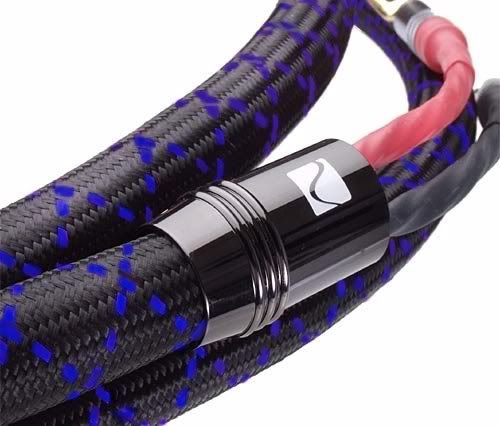
PS Audio xStream Resolution Reference Speaker Cable
While I was making new investigations in audio grade wire, I decided to revisit using better quality cables for the AI-1 Dreadnought. I had a pair of PS Audio xStream Resolution Reference speaker cables that had been in storage since being replaced by a pair of AudioQuest Volcanos in November of 2007. (PS-Audio-xStream-Resolution-Reference-Speaker-Cable-Review)
xStream Resolution Reference specifications:
11 AWG solid core conductors built from PCOCC (Pure Copper by Ohno Continuous Casting process) copper.
Hyper Litz counter spiral conductor configuration.
Price: $800 per 3 meter pair.
There have been some improvements in my two channel system since the original Dreadnought cable trials:
05/2009 PS Audio Soloist SE In-wall power line conditioners.
09/2009 PS Audio AC-12 power cords.
12/2009 Audiodharma Cable Cooker.
06/2010 Driver and tweeter retaining rings in SDA SRS 1.2TL speakers.
01/2011 Solen 10 AWG SDA inductor in SDA SRS 1.2TL speakers.
05/2011 Jantzen HF Inductors in SDA SRS 1.2TL speakers.
12/2011 Solen LF Inductors in SDA SRS 1.2TL speakers.
02/2012 1000 VA Dreadnought.
06/2012 Replace all stock JC 1 power amp fuses with HiFi Tuning fuses.
11/2012 Replace internal wire in SDA SRS 1.2TL speakers with AudioQuest GO-4.
11/2010 Custom crossover circuit board.
11/2011 HiFi Tuning Supreme fuses.
There were small, but easily heard, improvements with the xStream cables. I did listening tests with an xStream cable first on the right and then on the left, then on both sides. Quantitatively there was a little more detail, moreso at the sides of the sound stage. Spatially there was a little more image height overall and a little more depth at the sides of the sound stage.Proud and loyal citizen of the Digital Domain and Solid State Country!




